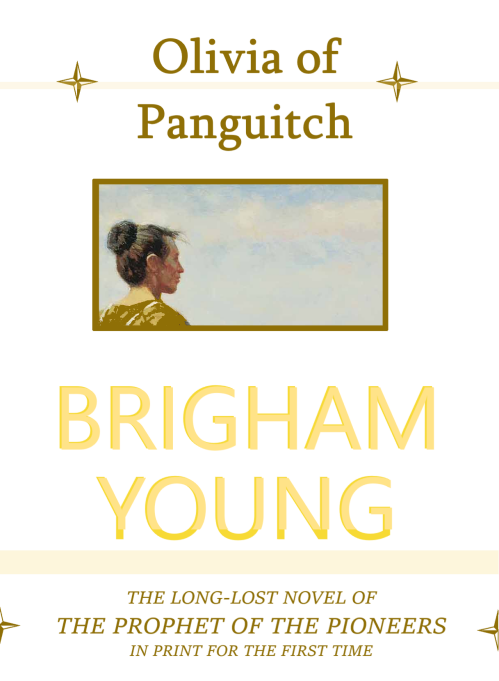 Title: Olivia of Panguitch
Title: Olivia of Panguitch
Author: Brigham Young
Publisher: Deseret Book
Genre: Once-Contemporary Fiction
Year Published: 2022
Binding: Hardback, ebook
Number of Pages: 286
Release date: July 2022 (final cover forthcoming)
Price: $28.99 (hardback), $14.99 (ebook)
Reviewed by Theric Jepson
Perhaps we should not be surprised that a man who spent years railing against the evils of the novel, the romance, fiction should have written one of his own. But that the novel in question should be not just passable but, by its conclusion, good? This is a shock.
Rumors of a Brigham Young-penned novel were long imagined to be a mere joke, a way to rib the old man about one of his many preoccupations, so when a cleaning crew shattered the ceramic pedestal upon which the Beehive House’s famed Apiary Clock had long stood and a manuscript was found, people’s hopes leapt first to lost theology (sealed Book of Mormon pages? a secret revelation?), not to fiction. Since that 2012 accident, the precise identity of the manuscript was kept quiet, but secrets find their way out and, not to put too fine a point on it, the Church’s opinion seems to be that Brother Brigham’s reputation would only be helped by publishing this charming (if sentimental) romance.
Those hoping for a radically Mormon take on the novel may be disappointed. The novel is lacking in big issues such as race or polygamy, where more information on the author’s opinions might be desired. What can be ascertained is some of Brigham Young’s own reading as large portions of the novel (as well as its basic plot) are plagiarized from Oliver Goldsmith’s The Vicar of Wakefield, the oft unhappy family transposed to southern Utah.
Which leads us to perhaps the most interesting aspect of the novel: that it takes place in a near-future southern Utah where the desert has blossomed as the rose and trains crisscross the landscape, carrying the finest goods and bringing the finest theater troupes to even the smallest of towns, all of which rival Nauvoo for size and glamour. (This comparison can be made with certainty, as one character says exactly this.)
While the novel may fail to tell us anything about the then Church President’s opinions on polygamy, it is notable that polygamy makes no appearance in the novel. Perhaps the sentimental tropes of the time did not allow for it; perhaps Brigham Young, like today’s screenwriters scrambling to build suspense in a world of cellphones, couldn’t imagine his Vicar of Wakefield in a world where men take multiple wives. So perhaps this exercise did teach him something about polygamy versus monogamy—and perhaps that lesson is part of the reason it was sealed away all these years.
Which brings us to what is (to this reviewer at least) the single more fascinating aspect of the novel, even more than trains filled with locally grown watermelons and fireworks straight from China: this story is told from its heroine’s perspective.
Vicar of Wakefield is the reminiscences of a vicar in his late life as he recounts his past. Olivia is told from his daughter’s perspective. And while the Olivia of Olivia is not much more modern than the Olivia of Vicar, just by virtue of spending these pages within her mind and her thoughts, the book, for all its plagiarisms, begins to sing a new song. The roughdraftiness of the novel comes through, as Olivia grows from parroting words and phrases from Goldsmith in a faux-feminine version of Young’s famous bombast, to a living, human woman, articulate in her own voice. The final thirty pages leave both Young and Goldsmith behind as this Olivia takes over her eponymous novel to speak words impossible to imagine either man writing.
I grow faint imagining what might have happened had our gruff old prophet kept his pen in hand and rewritten the entire novel from the perspective of this Olivia. More of this Olivia might not have led to a “verdant tropical forest along the Sevier River,” but imagine other changes to old Utah she might have effected!
So while the novel is largely amateur and plagiarized, these final pages where you get to meet—really truly meet—a woman named Olivia make the entire experience thrilling and important. You’ll be left wishing this first-time fictionist had developed his craft as ardently as he had once followed carpentry and glazing.
To think he spent his life building one world—
while another lived first in his imagination
and then on paper
buried beneath a clock.

LOL, I would so like to read this book!
I’m surprised this review wasn’t published 6 weeks ago.